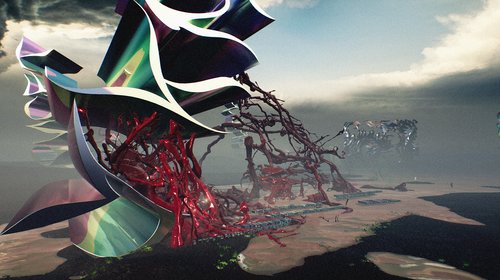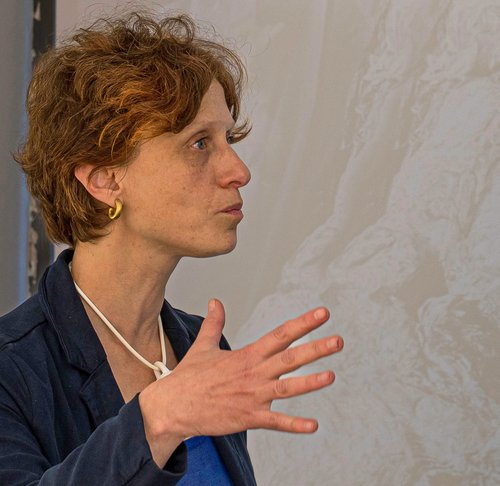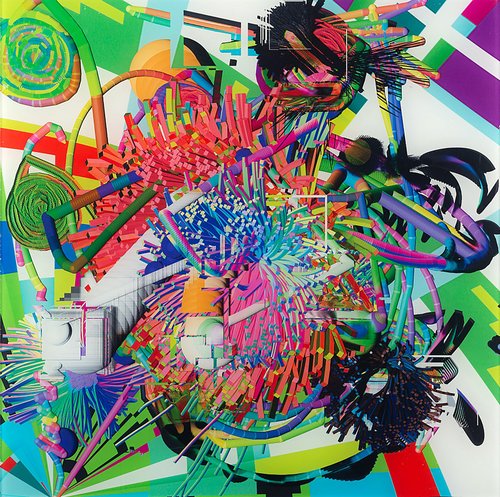Portrait of Vera Molnár, 1961. Photo by François Molnár, archives Vera Molnár. Courtesy of Galerie Oniris, Rennes
Vera Molnàr From Pencil to NFT
“When I started working with computers, outraged people said I was dehumanizing art”. Hungarian artist Vera Molnàr was ahead of her time, one of the earliest pioneers of digital art born a century ago, her work is being celebrated in a solo exhibition at the Centre Georges Pompidou in Paris, timed to coincide with what would have been her 100th Birthday.
‘Parler à l'œil’ is the title given by Vera Molnàr (1924–2023) herself to the exhibition at the Centre Georges Pompidou in Paris, organized to mark her 100th birthday, which refers to her idea that: “the art of painting begins on the retina, first of the painter, then of the viewer”. She was not to see the exhibition as she passed away just shy of her centenary in December last year. The exhibition includes her last monumental work ‘La vie en M’, which she had conceived for the show shortly before her death. Made from one hundred variations of the letter M superimposed one on top of the other and turned in various directions the installation splits up the entrance to the exhibition so that when visitors walk through it, they feel as if Vera Molnár herself has invited them to enter her world, through an open door.
Curator Christian Briend’s chronological ordering enables us to trace the evolution of Vera Molnár’s working method, a clever approach which, from her earliest works reveals the extent to which the desire to represent reality with the most minimal of means, with simple forms that exist in reality guided her even as a child when she regularly drew sunsets at dusk on the shores of Lake Balaton using just two bands of colour, water and sky, and a red disk. This red disk went on to become a constant element in her work throughout her life. You see it in her 1953 painting ‘Cercles et demi-cercles’, perhaps in part inspired by Auguste Herbin. This painting of red, black and grey circles and semicircles is the first work which greets visitors in the exhibition. Although the artist's earliest drawings are not on show, the landscape of ‘Geometric Hills’, created in 1946 when she was still a student, with its pencil strokes traced continuously on checked notebooks, sometimes touching, sometimes crossing, or ‘Trees and Hills’ of the same year, composed of a few vertical lines and circles, show the ground on which the impulses received in Paris a few years later were based. As a child Molnàr used coloured pastels in a special order that she conceived and would change each week, her first unconscious experience of programming.
Not long after she arrived in Paris, Molnàr met the French painter Félix Del Marle (1889–1952) who at the time was exploring Mondrianesque neoplasticism. “I learned a few things from him, including that a scientific approach is not an infallible path”, she told me in one of our many conversations. Then, in the second half of the 1950s, Molnár turned away from geometric abstraction and produced her first mature works, such as ‘4 Randomly Distributed Elements’ from 1959. This piece occupies an important place in her work, both because this is the first time she searched for variations, and because of the coloured ribbon strips, one of the first manifestations of Molnàr's various technical experiments. In the 1960s, the artist, who never ceased experimenting and searching, finally broke with the quasi-dogmatic rules of neoplasticism. Freed from the straitjacket of pure colours, using nine shades of red instead of the one authorized, dark cadmium, she created the ‘9 red squares’ in 1966. Her curiosity, which drove her to research and adventure, led her to invent her own programming, the ‘imaginary machine’. She drew different versions in pencil and kept on looking for possible variations until she found the one that suited her. It was of course a method which could only offer a small fraction of all possibilities. ‘A la recherche de Paul Klee’ created in ink on paper was conceived in 81 squares in 1969–70 and is Molnàr’s first series of algorithmic drawings. The series, whose starting point was Paul Klee’s 1927 painting ‘Variationen’, was once again the product of the “imaginary machine”. Like most of the works in the exhibition, this series is part of the Centre Pompidou collection.
In 1968, Vera Molnàr had her first opportunity to replace the imaginary machine with a real computer and she gave it tasks. She learned how to use it and then program it. The computer, far more productive than her previous methods, offered the artist a multiplicity of variations. From then on, Molnàr brought her generative drawings to life, thanks to a computer running programs and algorithms that she implemented. She became one of the real pioneers of digital art. In the 1970s, working with this method, she created several important series, including the ‘100 carrés poussés au bout’ (1976), a series of superimposed squares, and the ‘Molnaroglyphes’ (1975–1976), a series also using squares by varying their relative distances. Under this name, she also produced other series using geometric forms.
One of her unusual dypticals from the 1980s is ‘Transformation’ (1983), half of which is a light-grey-dark-grey image, while the other half, derived from it, is a dark-grey-black image, turned 180 degrees, transformed from positive to negative, from light to dark. As fate would have it, the two images, which were meant to be reunited, have changed hands over time, one now belongs to the Centre Pompidou collection, the other is in a private collection. Before her death, Molnàr requested them to be reunited in the Pompidou show.
Twenty-two of the forty Diaries created between 1976 and 2020, containing Vera Molnàr’s countless ideas recorded in drawings and annotations, are lined up in a display case. It was from these sketches and more elaborate drawings that Molnár realized her ideas, sometimes immediately after conceiving them or sometimes many years later. The idea for Albrecht's ‘Methamorphs’ was included in her diary in 1994, but she did not make the work until 2017. Four images are juxtaposed: the first shows Dürer’s iconic initials AD, which gradually change through different stages to become VM in the fourth and final image.
Vera Molnàr’s creative activity was always based on her deep interest in and knowledge of mathematics. Key to understanding her work, she often deliberately made small mistakes in her programming, creating a ‘1% disorder’, which made the result unpredictable and random. Although order was important to her in every respect, she disliked rigidity in both life and art.
Her unquenchable imagination constantly explored new ideas, which she realized in various forms: drawing, paper tearing, collage, photography, ropes driven through nails in the wall (OTTWW, 1981–2010), multiple works such as the metal sculpture with kinetic effects (Perspective d’un trait, 2014–2019) inspired by a computer-generated drawing. In her later years, she also added NFTs to her toolbox. In order to create she needed both individual freedom and creative freedom which let her imagination soar. The absence of this freedom is one of the main reasons why she left Hungary and moved to France. An autonomous artist, she always followed her own path, belonging to no movement or school. For a long time, her work was not taken seriously at all, and her computer projects were considered a whim, until she finally gained a following which continues to grow.
Julia Cserba´s conversations with Vera Molnàr in the early 2000s form the background to this article.






















